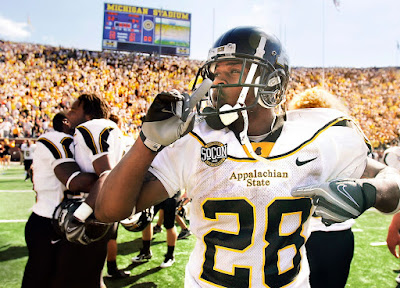They Might Be Giants
David and Goliath.
These names evoke a visual response in our mind's eye.
If an NCAA basketball tournament game is described as "David vs. Goliath," we get the metaphor. My favorite example is actually a football game, when Appy State went into "the big house" and beat the Michigan Wolverines in 2007. David took down Goliath. Even if you don't know about that game, you probably get the metaphor.
 |
| This game has it's own Wikipedia page. Fun reading if you're a Spartans fan. |
The story of David and Goliath is found in 1 Samuel 17. David is a shepherd, the youngest of eight sons. His three oldest brothers were in battle against the Philistines and one day David, at the request of his father, left the sheep to bring his big brothers some food.
When David arrives at the battle scene, he witnesses Goliath, a Philistine soldier, challenging the army of Israel to present a worthy foe. In 1 Samuel 17:4 (and later in 17:23), Goliath is called "the man between the two." Translations usually don't call him that. Most call him "champion." What he is, though, is the one who stands between two opposing groups, serving as the best representative of one army, challenging the other army to present their best. Hence, the man between the two. Hence, champion.
The Bible goes on to tell us that Goliath was "six cubits and a span." Since most of us don't use cubits or spans as measurements of length anymore, I'll let you know this means he was probably around 9 feet 9 inches tall. An imposing figure indeed.
But ancient manuscripts of 1 Samuel don't always agree as to how tall Goliath was. A lot of very important, very trustworthy manuscripts say that Goliath was "four cubits and a span" (about 6 feet 9 inches tall). Now at this point I could go into a lot of detail about ancient Hebrew manuscripts and the earliest Greek translations of the Hebrew scriptures and which ones say "six cubits" and which ones say "four cubits," but I suspect that would interest me a lot more than most of the people reading this post. In fact, there's even one manuscript that says "five cubits and a span." It's as if the scribe said, "A bunch of these say six cubits and a bunch of them say four cubits. I guess I'll split the difference."
Let me just say that good arguments have been made on both sides, but when one weighs the evidence of the relevant manuscripts, I think Goliath was probably "four cubits and a span." The oldest copy of 1 Samuel 17 says exactly that.
Also, it has been argued that at some point, a scribe's eyes accidentally jumped from "cubits" in verse 4 to "hundred" in verse 7 (the words look a lot alike in Hebrew), and the "six" found with "hundred" in verse 7 was then accidentally moved to verse 4. Just a slip of the eyes. Maybe you've done this when you were typing or writing.
I'm sure someone will read this and think, "Great. Here's one more guy trying to take the miraculous out of the Bible. Why can't he just accept the Bible as it is. If the word of God says a shepherd boy whooped a giant, then doggone it, a shepherd boy whooped a giant!"
Here's the thing. The Bible doesn't say that. In fact, Goliath is never called a giant in 1 Samuel 17. Don't take my word for it. Go. Read the story. I'll wait.
Told you.
I didn't take the giant out of the story. He was never there.
We have grown so accustomed to some of the stories of the Bible that we quit reading them with fresh eyes. Instead, we rely on our memory of the times we heard these stories in Sunday School, church camp, or sermons when we only half listened.
If Goliath is only "four cubits and a span," the story doesn't lose it's power. God used a shepherd boy who was delivering lunch to his soldier brothers to defeat a 6 foot, 9 inch champion (with a slingshot, by the way). Before the story is finished David decapitates Goliath with Goliath's own sword and delivers it to the king of Israel. There's plenty of power in the story, even if Goliath wasn't the tallest human being in the history of the human race.




Such a great point! With medical and other disciplines, we expect things to be research based, evidence based, etc., yet we take the "word of mouth" stories of the Bible as if they were real. Love your posts!
ReplyDeleteI like your stance on proving what the bible actually says and not going along with folklore. Also seeing that hebrew text made me realize just how cool it is that you can understand and read that. I mean I knew it but I guess never really grasped how difficult that seems to be before.
ReplyDeleteI think it's important to distinguish between what the Bible says and human tradition. Sometimes we simply don't give it a close reading because we think we already know the story. And sometimes folks don't want to give it a close reading for fear it won't line up with what they were taught. If the Bible is truly the Bible, it will survive. It seems to be doing just fine so far.
ReplyDeleteOne of my favorite professors used to say something like, "Allow the text to stand on its own and let the chips fall where they may." I've tried to adhere to that hermeneutic as best I can.
Great read!
ReplyDeleteA couple of thought I had that might support Goliath's "goliath" stature:
- 6'9'' is still tall by today's standards, and people are historically tall now by historical standards ... so *if* back then people were shorter than we're used to here in the West, he would have seemed exceptionally tall.
- Saul was unusually tall to begin with (over six feet at least, right?), so if he was afraid of Goliath as he stood from a distance, then maybe Goliath was super huge.
Another thought ... I read an interesting take on the fact that Goliath saw David holding "sticks" when he would have only been holding a single stick (his slingshot). Blurry vision is a side effect of a medical condition called "gigantism," which causes people to grow excessively huge due an abnormally high level of growth hormones.
DeleteI fully agree, 6'9" is tall by today's standards, which is my point exactly. For me, there's no reason to resort to mythological proportions for the height of Goliath, particularly since he's never called a giant in the text itself and the manuscript evidence seems to weigh in favor of 6'9".
DeleteSaul is really where our focus should lie when we read this story. The truth is, this is not the story of David and Goliath. Like most of 1 Samuel, it's the story of David and Saul.
Saul is described in 1 Samuel 9:2 as "from his shoulders and upward he was taller than all of the people" (literal translation of the Hebrew). That's all we get for his height, no specific measurements. Point is, he was taller than the Israelites who served in his army.
Now, why was Saul afraid of Goliath? Because of how tall he was? In 1 Samuel 17:11, we read, "When Saul and all Israel heard these words of the Philistine they were dismayed and greatly afraid." Nothing is mentioned about being afraid of his height. Later, David speaks with Saul about fighting Goliath and Saul tells David he can't fight Goliath because David is only a boy and Goliath has been "a man of battle from his youth." Again, no mention of the height of Goliath. Rather, the focus here is on Goliath's experience.
Interestingly side note, after David puts on Saul's armor he decides against wearing it. Not because it doesn't fit (the Bible never says that), but simply because he's not used to it.
Then David, a shepherd boy, goes out and does what the King of Israel, taller than all Israel and no doubt supplied with the best of armor and weaponry, was supposed to do. And David does it with a sling and a stone. That's why this is a story about David and Saul, not David and Goliath.
Concerning Goliath seeing sticks when it was just a singular stick, is that perhaps taking things a bit too literally? If my nephew came to my house with a Transformer and I said, "Oh cool! You brought your Transformers with you," I don't think anyone would be concerned that I have vision problems. Could it perhaps just be an expression? Just some of my thoughts, thanks for reading and conversing.